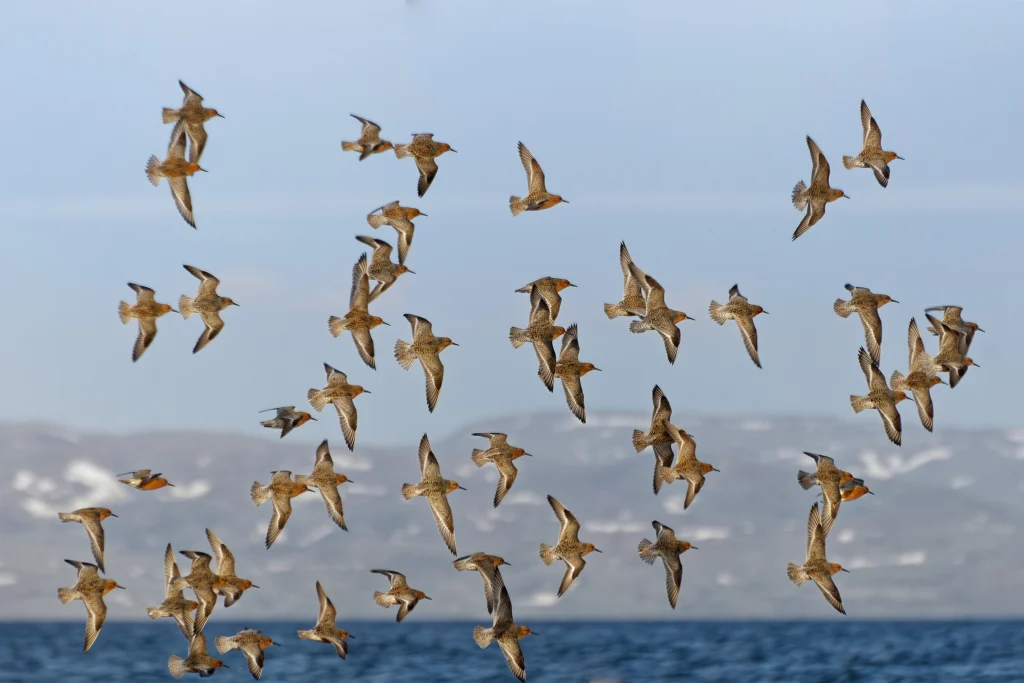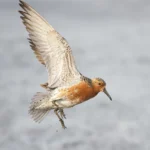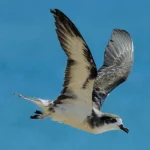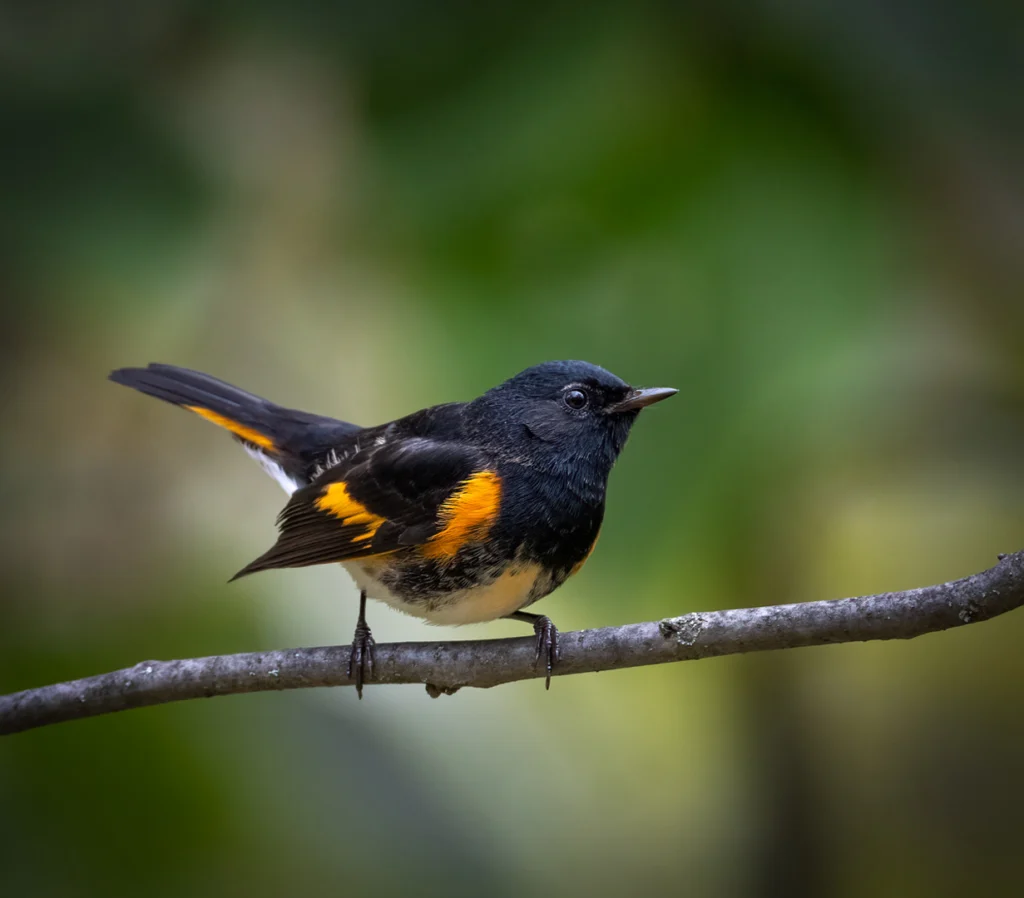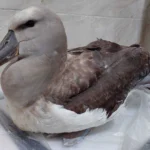
Overview
About
The rufous-breasted Red Knot, once known as the “Robin Snipe,” is a champion long-distance migrant, flying more than 9,000 miles from south to north every spring, then reversing the trip every autumn.
One tagged Red Knot lived to at least 19 years old. Over its lifetime, researchers estimate that this bird traveled farther than the distance from Earth to the Moon, hence its nickname, Moonbird.
The rufa Red Knot is one of six subspecies, three of which are found in North America. The rufa Red Knot’s migration along the eastern U.S. to its breeding grounds is timed to coincide with the spawning season of the horseshoe crab, as its massive outlay of eggs provides a rich, easily digestible food source for the knot and other migrating shorebirds such as the Ruddy Turnstone, Semipalmated Sandpiper, and Dunlin. Delaware Bay shores provide the single most important spring stopover area for the rufa Red Knot, hosting within a narrow time window up to 90 percent of the North American population. Other key U.S. stopover sites include coastal islands off of Georgia, South Carolina, Virginia, and Massachusetts.
Threats
The rufa subspecies of Red Knot was federally listed as a Threatened species in 2014, as its numbers had declined about 75 percent from the 1980s to the 2000s due to overharvesting of horseshoe crabs, coastal development, and sea level rise.
Fisheries
Beginning in the 1980s, people began to harvest horseshoe crabs in unsustainable numbers for conch and eel bait, which fueled steep declines of both horseshoe crabs and Red Knots. Today, a leading cause of horseshoe crab decline — and by extension, decreasing Red Knot numbers — is their use in biomedical testing. The crabs’ blue blood is sensitive to endotoxins and is used to test human drugs and medical devices for contamination. Humans also use the horseshoe crab for fertilizer and livestock feed.
Climate Change
Global warming may degrade and destroy habitat throughout the Red Knot’s range, from its breeding grounds in the High Arctic to its nonbreeding grounds along sandy shorelines in the southern United States, the Caribbean, and South America. All major migration staging sites are also on coastlines, which will be impacted by rising sea levels.
Conservation Strategies & Projects
ABC has successfully advocated for horseshoe crab harvest restrictions in Mid-Atlantic states and for the creation of a horseshoe crab sanctuary at the mouth of Delaware Bay.
Protecting Migration
Conserving important migratory bird stopover sites such as the Delaware Bay, plus breeding and wintering areas, remains a focus of ABC’s BirdScapes approach.
Support Petitions & Advocacy
ABC was instrumental in the Red Knot’s listing as Threatened under the Endangered Species Act in 2015. We have also advocated for horseshoe crab harvest restrictions in Mid-Atlantic states, and are a member of the Horseshoe Crab Recovery Coalition, a partnership of more than 50 organizations advocating for solutions to conserve both the horseshoe crab and the Red Knot.
Bird Gallery
The Red Knot is a stocky, medium-sized shorebird with a rather short bill and legs. It is unmistakable in its breeding plumage, with an intricately patterned gray, black, and rufous back and rich salmon-colored underparts. Once the breeding season ends this species molts into a duller basic plumage of pale gray and white, with dark barring on the flanks. Juveniles in the nonbreeding season are similarly nondescript but show a scaly pattern on the back feathers.

Sounds
The Red Knot makes a variety of calls, including a chatter often heard during aggressive encounters. Its song is a whistled poor-mee. Below, hear the song of a male Red Knot of the roselaari subspecies, recorded near Nome, Alaska.
Andrew Spencer, XC134984. Accessible at www.xeno-canto.org/134984.
Habitat
The rufa Red Knot breeds in the Arctic regions of North America, close to streams or ponds, and usually near the coast. It spends the nonbreeding season along shorelines in the southeastern U.S. and South America.
- Favors higher-elevation, sparsely vegetated tundra and gravely slopes in the breeding season, with juveniles moving to sedge meadows and lakeshores to prepare for migration
- Uses tidal flats, rocky shorelines, and sandy beaches as stopover and wintering habitat throughout its nonbreeding range

Range & Region

Specific Area
Found on all continents except Antarctica; rufa subspecies breeds in the High Arctic in central Canada, and is found in the southeastern U.S., the Caribbean, Brazil, Chile, and Argentina in the nonbreeding season
Range Detail
Three of the six Red Knot subspecies are found in North America, and all three are in decline. Eastern North America’s rufa subspecies was listed as Threatened under the Endangered Species Act in 2015.
Rufa Red Knots breed in the central Canadian Arctic and inhabit three distinct regions in the nonbreeding season: Florida and the adjacent Gulf Coast and the Caribbean, northern Brazil, and the Chilean and Argentine Tierra del Fuego. Another North American subspecies is found along the West Coast, and the third nests in northeastern Canada and Greenland, wintering in Europe. The other three subspecies occur in Europe and Asia. Highly social outside the breeding season, Red Knots often migrate and winter in large flocks.
Did you know?
The rufa subspecies of Red Knot has one of the longest migratory journeys of any animal, traveling an astonishing 18,000 miles (or more) in one year. That’s like making more than six trips back and forth between Florida and Washington state! Their migration is closely linked to the timing of horseshoe crab spawning in the Delaware Bay — on a single day during migration, almost 90 percent of the entire rufa subspecies population may be present in the bay, feasting on protein-dense crab eggs.
Life History
When preparing for migration to the breeding grounds, Red Knots pack on extraordinary amounts of weight to fuel their long flights. When they reach the Delaware Bay, exhausted and emaciated, the birds must regain the fat they lost in the first leg of their journey, and pile on even more. Often, Red Knots almost double in weight while feasting on protein-rich horseshoe crab eggs — one of the highest rates of mass gain of any vertebrate.

Diet
A wide variety of marine and freshwater invertebrates sustain Red Knots on their nonbreeding grounds and during migration. In addition to horseshoe crab eggs, these shorebirds gobble up aquatic insects, small snails and other mollusks, and worms. Prey is captured by probing into the sand and mud of beaches and marshes.
Once on their breeding grounds, Red Knots feed on the Arctic region’s abundant summertime insect swarms, occasionally supplementing their diet with seeds, buds, and plant shoots.
Courtship
When a male Red Knot reaches the breeding grounds, he stakes out and aggressively defends a territory, driving away any competing knots in aerial chases. Newly arriving females are treated to dramatic flight displays. Males fly high — sometimes over 900 feet — on trembling, rapid wingbeats, then glide slowly back to the ground while calling.
Nesting
A male Red Knot will fashion three to five nest scrapes in his territory, usually near water in stony upland tundra. Once a female arrives, she chooses one of these for her nest, then lines the depression with lichens, leaves, and moss.
Eggs & Young
The female knot lays a single clutch of four eggs, which both parents incubate. Like the Snowy Plover, Killdeer, and many other ground-nesting birds, the Red Knot performs distraction displays to lead intruders and potential predators away from the nest site.
Red Knot chicks hatch downy and alert, and leave the vicinity of their nests almost immediately. Although still flightless, as they grow, these birds garner protection from their cryptic plumage and their “freeze” responses to parental alarm calls.
